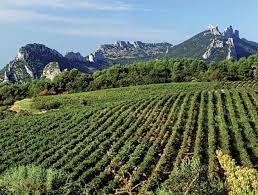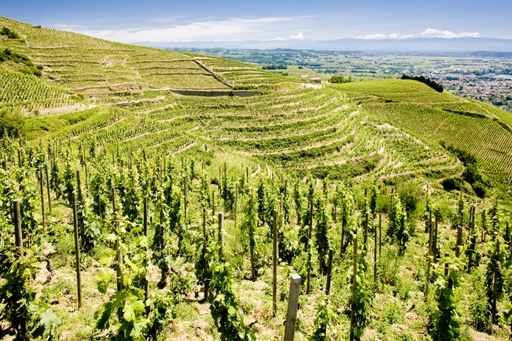Côtes-du-Rhône and the Rhône Valley is the wine district which follows along the Rhône river. This is the second largest French wine region after Bordeaux. From Lyon direction south towards the Mediterranean, the solar radiation effects on grapes spring to mind when tasting these wines. Spice, power and alcohol strength tend to be characteristic for the Côtes-du-Rhône wines. Historically, the Côtes-du-Rhône had a relatively simple reputation. In recent decades, however, the rumor has evolved and today this region produces wines which according to many guides, not least in the United States, are considered the best wines in the world.
 Côtes-du-Rhône wines should not be lumped together, the difference is great between the different appellations. To get a better idea, the Côtes-du-Rhône should be divided into three different geographical districts. First, the district north of Valence, where the climate is continental with a soil composed of granite and slate. The vineyards are conducted on steep hills that make it extremely difficult to harvest the grapes. This area produces wonderful red wines out of Syrah grapes. Marsanne and Roussanne and Viognier are used for the whites. In the middle of Côtes-du-Rhône, the climate is inspired by the mountain hills and the soil is calcareous. Clairette and Muscat are varieties used here. The south of Montelimar, is the sun’s kingdom and also the warmest part of the Côtes-du-Rhône. The soil here vary, but is generally calcareous. The most widely used grape variety is Grenache, but since the climate can be harsh and whimsical,both when comes to heat and cold, other grape varieties are also cultivated as a kind of “insurance”. If the Grenache grape one year would suffer from the climate, other grape varieties are used to produce well-balanced wines: Syrah, Mourdèvre, Cinsault, Clairette, Bourboulenc and Roussanne are all authorized varieties for wines from this part of the Côtes-du-Rhône. Chateau-neuf-du-Pape can contain up to 13 different grape varieties.
Côtes-du-Rhône wines should not be lumped together, the difference is great between the different appellations. To get a better idea, the Côtes-du-Rhône should be divided into three different geographical districts. First, the district north of Valence, where the climate is continental with a soil composed of granite and slate. The vineyards are conducted on steep hills that make it extremely difficult to harvest the grapes. This area produces wonderful red wines out of Syrah grapes. Marsanne and Roussanne and Viognier are used for the whites. In the middle of Côtes-du-Rhône, the climate is inspired by the mountain hills and the soil is calcareous. Clairette and Muscat are varieties used here. The south of Montelimar, is the sun’s kingdom and also the warmest part of the Côtes-du-Rhône. The soil here vary, but is generally calcareous. The most widely used grape variety is Grenache, but since the climate can be harsh and whimsical,both when comes to heat and cold, other grape varieties are also cultivated as a kind of “insurance”. If the Grenache grape one year would suffer from the climate, other grape varieties are used to produce well-balanced wines: Syrah, Mourdèvre, Cinsault, Clairette, Bourboulenc and Roussanne are all authorized varieties for wines from this part of the Côtes-du-Rhône. Chateau-neuf-du-Pape can contain up to 13 different grape varieties.
There are 2 regional Côtes-du-Rhône appellations:
- Côtes du Rhône: wines that are included in this appellation cover the entire wine district. At least 40% Grenache should be used and Grenache, Syrah and Mourdèvre should represent at least 70% of the final wine.
- Côtes du Rhône Villages: some municipalities within the Côtes-du-Rhône region has achieved a status in order to differentiate themselves from other Côtes-du-Rhône wines, claiming their municipality’s name on the label. The rules that the winegrower must respect in order to reach this level, is somewhat higher than for a standard Côtes-du-Rhône, mainly regarding the grape’s geographical origin, the harvest yields per square meter and the alcohol strength.
18 villages have been given the opportunity to, besides Côtes-du-Rhône, also claim their names on the label. The best known are: Rasteau Cairanne, Valréas and Visan. These villages are well worth remembering as they often produce superb wines. Beside these two regional appellations, there are also the communal appellations which are part of the Côtes du Rhône wine region. These communal appellations claim the municipal name on the label without mentioning Côtes-du-Rhône. These municipal appellations are divided into two categories depending on whether they are from the northern Côtes-du-Rhône or the south.

These communal appellations are often called “crus” and considered by many international wine specialists to represent some of the world’s best wines:
- The northern communal appellations (between Vienne and Valence): Côtes-Rôtie, Condrieu, Saint-Joseph, Crozes-Hermitage, Hermitage, Cornas, Saint-Péray, Clairette-they-die, Crémant-de-die, Châtillon-en -diois.
- The southern communal appellations (from Valence and down): Vinsobres, Gigondas, Beaumes-de-Venise, Vacqueyras, Chateauneuf-du-Pape, Lirac, Picture, Costières-de-Nimes, Coteaux-de-Tricastin, Ventoux, the Luberon, pierrevert, Côtes-du-Vivarais.


